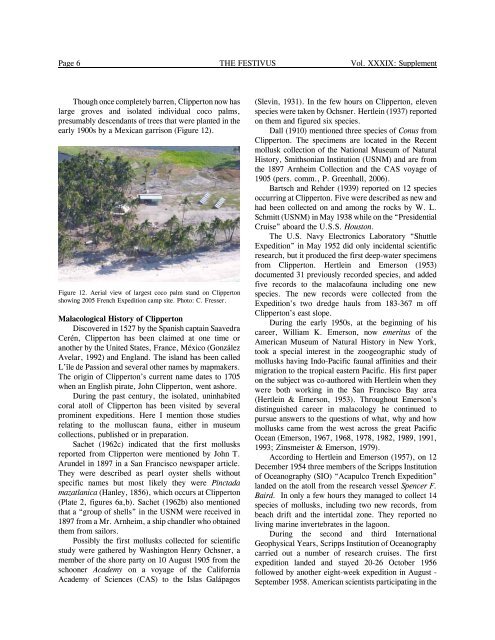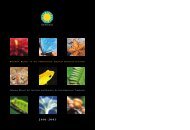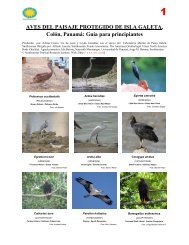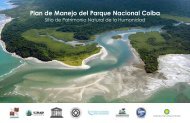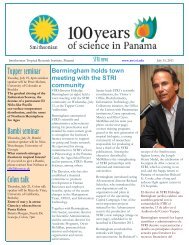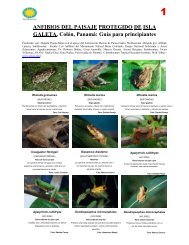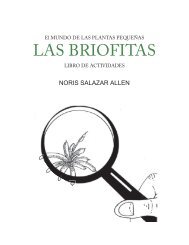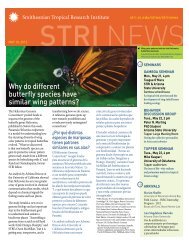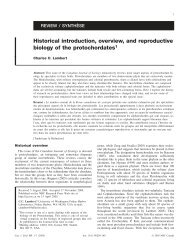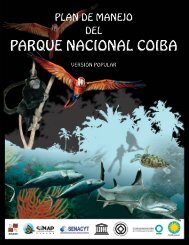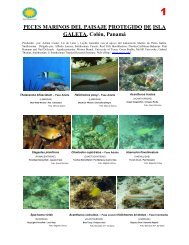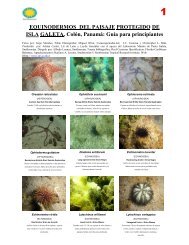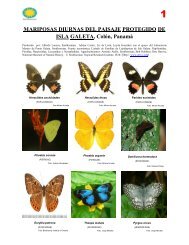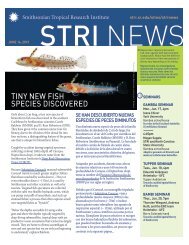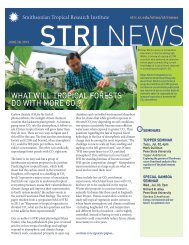Download - Smithsonian Tropical Research Institute - Smithsonian ...
Download - Smithsonian Tropical Research Institute - Smithsonian ...
Download - Smithsonian Tropical Research Institute - Smithsonian ...
Create successful ePaper yourself
Turn your PDF publications into a flip-book with our unique Google optimized e-Paper software.
Page 6 THE FESTIVUS Vol. XXXIX: Supplement<br />
Though once completely barren, Clipperton now has<br />
large groves and isolated individual coco palms,<br />
presumably descendants of trees that were planted in the<br />
early 1900s by a Mexican garrison (Figure 12).<br />
Figure 12. Aerial view of largest coco palm stand on Clipperton<br />
showing 2005 French Expedition camp site. Photo: C. Fresser.<br />
Malacological History of Clipperton<br />
Discovered in 1527 by the Spanish captain Saavedra<br />
Cerén, Clipperton has been claimed at one time or<br />
another by the United States, France, México (González<br />
Avelar, 1992) and England. The island has been called<br />
L’île de Passion and several other names by mapmakers.<br />
The origin of Clipperton’s current name dates to 1705<br />
when an English pirate, John Clipperton, went ashore.<br />
During the past century, the isolated, uninhabited<br />
coral atoll of Clipperton has been visited by several<br />
prominent expeditions. Here I mention those studies<br />
relating to the molluscan fauna, either in museum<br />
collections, published or in preparation.<br />
Sachet (1962c) indicated that the first mollusks<br />
reported from Clipperton were mentioned by John T.<br />
Arundel in 1897 in a San Francisco newspaper article.<br />
They were described as pearl oyster shells without<br />
specific names but most likely they were Pinctada<br />
mazatlanica (Hanley, 1856), which occurs at Clipperton<br />
(Plate 2, figures 6a,b). Sachet (1962b) also mentioned<br />
that a “group of shells” in the USNM were received in<br />
1897 from a Mr. Arnheim, a ship chandler who obtained<br />
them from sailors.<br />
Possibly the first mollusks collected for scientific<br />
study were gathered by Washington Henry Ochsner, a<br />
member of the shore party on 10 August 1905 from the<br />
schooner Academy on a voyage of the California<br />
Academy of Sciences (CAS) to the Islas Galápagos<br />
(Slevin, 1931). In the few hours on Clipperton, eleven<br />
species were taken by Ochsner. Hertlein (1937) reported<br />
on them and figured six species.<br />
Dall (1910) mentioned three species of Conus from<br />
Clipperton. The specimens are located in the Recent<br />
mollusk collection of the National Museum of Natural<br />
History, <strong>Smithsonian</strong> Institution (USNM) and are from<br />
the 1897 Arnheim Collection and the CAS voyage of<br />
1905 (pers. comm., P. Greenhall, 2006).<br />
Bartsch and Rehder (1939) reported on 12 species<br />
occurring at Clipperton. Five were described as new and<br />
had been collected on and among the rocks by W. L.<br />
Schmitt (USNM) in May 1938 while on the “Presidential<br />
Cruise” aboard the U.S.S. Houston.<br />
The U.S. Navy Electronics Laboratory “Shuttle<br />
Expedition” in May 1952 did only incidental scientific<br />
research, but it produced the first deep-water specimens<br />
from Clipperton. Hertlein and Emerson (1953)<br />
documented 31 previously recorded species, and added<br />
five records to the malacofauna including one new<br />
species. The new records were collected from the<br />
Expedition’s two dredge hauls from 183-367 m off<br />
Clipperton’s east slope.<br />
During the early 1950s, at the beginning of his<br />
career, William K. Emerson, now emeritus of the<br />
American Museum of Natural History in New York,<br />
took a special interest in the zoogeographic study of<br />
mollusks having Indo-Pacific faunal affinities and their<br />
migration to the tropical eastern Pacific. His first paper<br />
on the subject was co-authored with Hertlein when they<br />
were both working in the San Francisco Bay area<br />
(Hertlein & Emerson, 1953). Throughout Emerson’s<br />
distinguished career in malacology he continued to<br />
pursue answers to the questions of what, why and how<br />
mollusks came from the west across the great Pacific<br />
Ocean (Emerson, 1967, 1968, 1978, 1982, 1989, 1991,<br />
1993; Zinsmeister & Emerson, 1979).<br />
According to Hertlein and Emerson (1957), on 12<br />
December 1954 three members of the Scripps Institution<br />
of Oceanography (SIO) “Acapulco Trench Expedition”<br />
landed on the atoll from the research vessel Spencer F.<br />
Baird. In only a few hours they managed to collect 14<br />
species of mollusks, including two new records, from<br />
beach drift and the intertidal zone. They reported no<br />
living marine invertebrates in the lagoon.<br />
During the second and third International<br />
Geophysical Years, Scripps Institution of Oceanography<br />
carried out a number of research cruises. The first<br />
expedition landed and stayed 20-26 October 1956<br />
followed by another eight-week expedition in August -<br />
September 1958. American scientists participating in the


